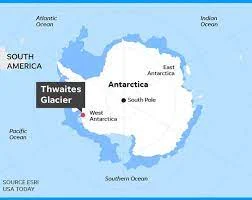Scientists have warned that one of the most significant glaciers in the Antarctica is at serious risk of collapse because of being loosened by warmer temperatures in the surrounding seas, with the potential for globally significant consequences.
The Thwaites Glacier, also known as the Doomsday glacier because of the impact its melting would have, flows into the Amundsen Sea off western Antarctica and is around the same size as Great Britain or Florida.
Opinion on its longevity is divided, but at a meeting of the American Geophysical Union on Monday, some delegates suggested it could have as little as five years left before the continued erosion of its ice from beneath would lead to a greater rate of fracturing higher up, which could result in a serious raising of global sea levels.
"There is going to be dramatic change in the front of the glacier, probably in less than a decade. Both published and unpublished studies point in that direction," said glaciologist Ted Scambos from the International Thwaites Glacier Collaboration to the BBC. "This will accelerate the pace and widen, effectively, the dangerous part of the glacier."
The Science News website quoted him as saying that carbon dioxide emissions were significantly to blame.
- Rising sea levels
Erin Pettit, another glaciologist from Oregon State University, told broadcaster CNBC that rising sea levels were a near inevitability and the focus should now turn to how to manage their environmental impact.
Scambos said Thwaites is the widest glacier in the world, and it has doubled the outflow speed of the water it has released over the last 30 years. It holds enough water to raise global sea levels by more than 60 centimeters. And were it to be significantly damaged, it could also impact other surrounding glaciers, compounding the problem.
On the website of scientific journal Science, it stated that diagonal fractures have been spotted spanning nearly the entire length of the glacier's ice shelf, adding to fears about its stability.
Scientists from the British Antarctic Survey have been part of a team using hot water to drill access holes into the ocean cavity hundreds of meters below the ice shelf to assess conditions within.
It reported that water in the area known as the grounding zone, where the glacier lifts off the sea bed, was uncharacteristically warm and also salty, two factors which are regarded as likely to increase the chances of significant melting from below the surface.
--

No comments:
Post a Comment
Only News